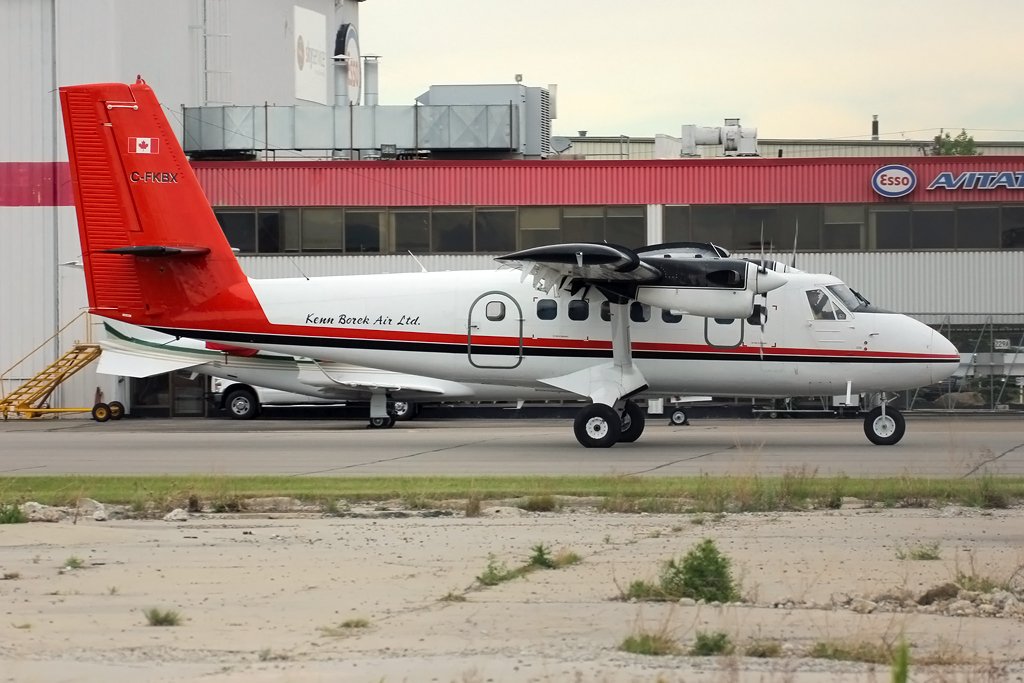The Twin Otter In Detail
Identify the 300 Series Aircraft Below
Answer is at the bottom of the page



DHC-6 Engine Types
Pratt & Whitney Canada PT6A-20, 550 SHP
Pratt & Whitney Canada P6TA-27, 620 SHP
Pratt & Whitney Canada PT6A-34, 750 SHP
DHC-6 Propeller Types
Hartzell HC-B3TN-3, 3B, 3BY 3 Bladed Propeller
Raisbeck/Hartzell HC-D4N-3A 4 Bladed Propeller
McCauley 4HFR34C764 4 Bladed Propeller
MT-Propeller MTV-16-1-ECFR 4 Bladed Propeller
DHC-6 Gear Types
The Twin Otter can be operated with a variety of wheeled landing gear types, as well as straight skis, and wheel/skis. In support of off-strip tundra operations, the aircraft can be equipped with flotation gear as seen in pictures 2 and 3 below. Because of the size of the intermediate flotation tire on the nose, an extended nose fork is required, giving the aircraft a nose high stance on the ground. When high flotation main gear tires are installed, along with the intermediate nose gear, the aircraft returns to more of a level profile.
Standard Commuter Arrangement Standard size main wheels, standard size nose wheel
Intermediate Flotation Gear Intermediate size main wheels, intermediate size nose wheel
High Flotation Gear High flotation main wheels, intermediate flotation nose wheel
Straight Skis
Wheel Skis
DHC-6 Float Types
CAP 12000 Floats - Non amphibious (seen on Beaching Gear)
CAP 12000 Floats - Non-Amphibous (seen on Beaching Gear)
Wipline® 13000 Floats - Non-Amphibious
Wipline® 13000 Floats - Non-Amphibious (seen on beaching gear)
Wipline® 13000 Floats - Amphibious
Wipline® 13000 Floats - Amphibious
DHC-6 Main Cabin Door Types
Standard Clamshell Doors with Airstair
Standard Clamshell Door, without Airstair
Inward Folding Utility Door
Ikhana Roll-up Skydiving Door
DHC-6 Forward Crew Doors
Forward Crew Door - Starboard
Forward Crew Door - Port
DHC-6 Forward Emergency Exits Arrangements
The Twin Otter Series 100 & 200 aircraft were built, received regulator approval, and were delivered without forward emergency window exits, but with a single roof hatch exit. They can be identified by seeing 7 equally spaced windows on the port side, and 8 equally spaced windows on the starboard side, ahead of the aft doors.
While production was continuing under the original approval, the U.S. FAA issued an order for the installation of forward emergency exits, retroactively back to MSN 6, if the aircraft was air carrier operated under FAR Part 135. Exempted from the regulation were non Part 135, non-airline airframes. Retrofit STC’s were created to accommodate this change in the regulations. Version A is a somewhat odd looking square exit placed at cabin window 1, necessitating the removal of cabin window 2. Version B is a conventional Type III window exit, placed at cabin window 2, and necessitating the removal of cabin window 3.
The Twin Otter Series 300 were built and delivered with the Version B Type III exit, that was required by U.S. Part 135 requirements regardless of what jurisdiction the aircraft was being delivered to. Should the country’s regulators not require the additional exit windows, they could be deactivated.
So in 2022, it is possible to see Twin Otter’s of all three exit arrangements still operating.
Forward Roof Hatch Exit
Forward Emergency Exit Type A Closed
Forward Emergency Exit Type B (Closed)
Forward Emergency Exit Type B - Open
DHC-6 Aft Starboard Exit
Aft Cabin Door (Closed)
Aft Cabin Door (Open)
Aft Cabin Door, with bubble observation window
Aft Cabin Door with rectangular observation window
Answer to “Identify the Series 300 Aircraft Below”
Many Twin Otter fans assume that if the aircraft has a short nose, then it must be an “old 100”. Actually of the legacy models 100, 200 & 300, all of them can be equipped with a short nose or long nose dependent on the requirements of the operator. The only caveat being that if operated on CAP 12000 floats, all must have the short nose installed. The Wipline° 13000 series floats are approved with the long nose installed.
Twin Otter Series 400 aircraft are built and approved only with the long nose.



































